- Python Basic Programs
- Python Program Examples
- Python Print Hello World
- Python Get Input from User
- Python Add Two Numbers
- Add Subtract Multiply Divide
- Python Check Even or Odd
- Python Check Prime or Not
- Python Check Alphabet or Not
- Python Check Vowel or Not
- Python Check Leap Year or Not
- Check Reverse equal Original
- Check Positive Negative Zero
- Python Check Armstrong or Not
- Python Check Palindrome or Not
- Python Check Perfect Number
- Python Find Reverse of Number
- Python Count Digits in Number
- Python Add Digits of Number
- Sum of First and Last Digits
- Python Product of Mid Digits
- Sum of Squares of Digits
- Interchange Digits of Number
- Python Sum of n Numbers
- Python Print ASCII Values
- Python Swap Two Numbers
- Python Swap Two Variables
- Python Fahrenheit to Celsius
- Python Celsius to Fahrenheit
- Python Display Calendar
- Python Days into Years, Weeks
- Find Largest of Two Number
- Find Largest of Three Number
- Python Print Fibonacci Series
- Generate Armstrong Numbers
- Python Make Simple Calculator
- Python Add Binary Numbers
- Binary Number Multiplication
- Python Mathematical Programs
- Find Sum of Natural Numbers
- Find Average of n Numbers
- Python Print Multiplication Table
- Print Table using Recursion
- Python Find Average Percentage
- Python Find Grade of Student
- Find Square Root of Number
- Python Print Prime Numbers
- Find Numbers Divisible by
- Python Find Factors of Number
- Python Find Factorial of a Number
- Python Find HCF & LCM
- Python Kilometres to Miles
- Python Find Area of Square
- Python Find Area of Rectangle
- Python Find Area of Triangle
- Python Find Area of Circle
- Python Find Perimeter of Square
- Find Perimeter of Rectangle
- Python Find Perimeter of Triangle
- Find Circumference of Circle
- Python Simple Interest
- Python Solve Quadratic Equation
- Python Different Set of Operations
- Python Display Powers of 2
- Python Find nCr & nPr
- Python Pattern Programs
- Python Print Pattern Programs
- Python Print Diamond Pattern
- Python Print Floyd's Triangle
- Python Print Pascal's Triangle
- Python List Programs
- Python Count Even/Odd in List
- Python Positive/Negative in List
- Python Even Numbers in List
- Python Odd Numbers in List
- Python Sum of Elements in List
- Sum of Odd/Even Numbers
- Python Element at Even Position
- Python Element at Odd Position
- Python Search Element in List
- Python Largest Number in List
- Python Smallest Number in List
- Python Second Largest in List
- Python Second Smallest in List
- Python Insert Element in List
- Python Delete Element from List
- Python Multiply Numbers in List
- Swap Two Elements in List
- Python 1D Array Program
- Python Linear Search
- Python Binary Search
- Python Insertion Sort
- Python Bubble Sort
- Python Selection Sort
- Remove Duplicates from List
- Python Reverse a List
- Python Merge Two List
- Python Copy a List
- Python Conversion Programs
- Python Decimal to Binary
- Python Decimal to Octal
- Python Decimal to Hexadecimal
- Python Binary to Decimal
- Python Binary to Octal
- Python Binary to Hexadecimal
- Python Octal to Decimal
- Python Octal to Binary
- Python Octal to Hexadecimal
- Python Hexadecimal to Decimal
- Python Hexadecimal to Binary
- Python Hexadecimal to Octal
- Python Matrix Programs
- Python Add Two Matrices
- Python Subtract Two Matrices
- Python Transpose Matrix
- Python Multiply Matrices
- Python String Programs
- Python Print String
- Python Find Length of String
- Python Compare Two Strings
- Python Copy String
- Python Concatenate String
- Python Reverse a String
- Python Swap Two Strings
- Python Uppercase to Lowercase
- Python Lowercase to Uppercase
- Python Check Substring in String
- Python Count Character in String
- Count Repeated Characters
- Python Count Word in Sentence
- Python Count Each Vowels
- Python Capitalize Character
- Python Capitalize Word in String
- Python Smallest/Largest Word
- Remove Spaces from String
- Remove Duplicate Character
- Remove Vowels from String
- Remove Punctuation from String
- Python Remove Word in String
- Python Remove Duplicate Words
- WhiteSpace to Hyphens
- Replace Vowels with Character
- Replace Character in String
- Python Sort String in Alphabetical
- Sort Word in Alphabetical Order
- Extract Number from String
- Python Check Anagram Strings
- Python File Programs
- Python Read a File
- Python Write to File
- Python Append Text to File
- Python Copy Files
- Python Merge Two Files
- Python Counts Characters in File
- Python Count Words in File
- Python File Content in Reverse
- Python Lines Contains String
- Python Delete Line from File
- Python Capitalize Word in File
- Python Replace Text in File
- Replace Specific Line in File
- Python Find Size of File
- Python List Files in Directory
- Python Delete Files
- Python Misc Programs
- Python Reverse a Tuple
- Python Merge Two Dictionary
- Python bytes to String
- Python bytearray to String
- Generate Random Numbers
- Python Print Address of Variable
- Python Print Date and Time
- Python Get IP Address
- Python Shutdown/Restart PC
- Python Tutorial
- Python Tutorial
Python Program to Insert Element in a List
This article is created to cover some programs in Python, that inserts an (or more) element(s) in a list at end or any particular index (or position). Both element and list must be entered by user at run-time. Here are the list of programs:
- Insert an Element at the End of a List
- Insert Multiple Elements at the End of a List
- Insert an Element at a Specific (Particular) Position in a List
- Insert Multiple Elements at Some Specified Indexes in a List
Insert an Element at the End of a List
This program inserts an element entered by user at the end of a list. The question is, write a Python program to insert an element in a list. Here is its answer:
print("Enter 10 Elements of List: ") nums = [] for i in range(10): nums.insert(i, input()) print("Enter an Element to Insert at End: ") elem = input() nums.append(elem) print("\nThe New List is: ") print(nums)
Here is its sample run:

Now supply the input say 1, 2, 3, 4, 5, 6, 7, 8, 9, 10 as ten numbers, then 11 as a number to insert in the list:
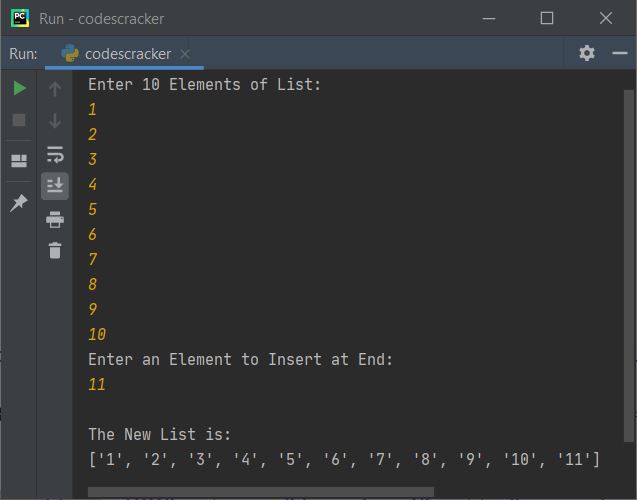
In above program, the following statement:
nums.insert(i, input())
states that, entered value gets initialized at ith index of nums. For example, if user enters 10 and the current value of i is 2, then 10 gets initialized to nums[2]. Since initially the list nums is empty, then you can also replace the above statement with statement given below:
nums.append(input())
Note - The append() method appends an element (provided as its argument) at the end of list.
Note - An empty list can also be defined using nums = list()
Modified Version of Previous Program
This program allows user to define the size of list. The end used in this program, to skip inserting an automatic newline. The str() converts any type of value to a string type.
print("Enter the Size: ", end="") try: numsSize = int(input()) print("Enter " +str(numsSize)+ " Elements: ", end="") nums = [] for i in range(numsSize): nums.append(input()) print("\nEnter an Element to Insert at End: ") elem = input() nums.append(elem) numsSize = numsSize+1 print("\nThe New List is: ") for i in range(numsSize): print(end=nums[i] + " ") print() except ValueError: print("\nInvalid Input!")
Here is its sample run with user input, 5 as size, 1, 2, 3, 4, 5 as five elements, 2 as element to insert at end of given list:
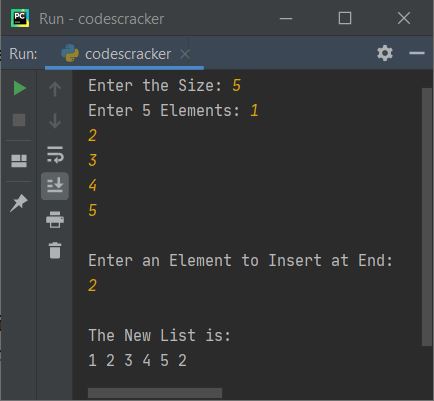
Here is another sample run with user input, 11 as size, c, o, d, e, s, c, r, a, c, k, e as eleven elements, and then r as element to insert at end of list:
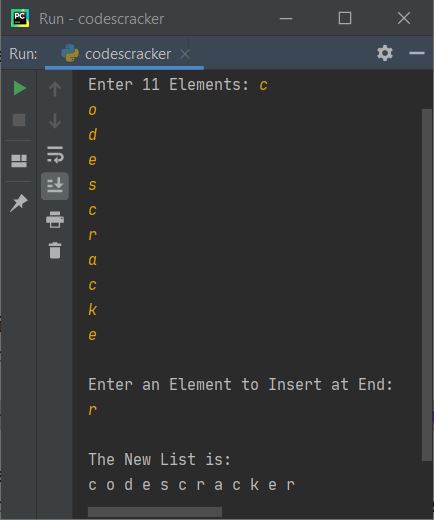
From above program, the following statement:
print(end=nums[i] + " ")
can also be written as:
print(nums[i], end=" ")
Note - The try-except is used to handle with invalid inputs. The first statement of try, that is numsSize = int(input()) gets executed, that wants to receive an integer input from user. But if user enters a non-integer value, then it raises an ValueError, therefore program flow goes to except ValueError's body and prints a message whatever the programmer specified.
Insert Multiple Elements at the End of a List
This program allows user to insert multiple (more than one) elements at the end of a list, at one execution of the program. Let's have a look at the program first:
print("Enter Size: ", end="") try: tot = int(input()) print("Enter " +str(tot)+ " Elements: ", end="") arr = list() for i in range(tot): arr.append(input()) print("\nThe List is:") for i in range(len(arr)): print(arr[i], end=" ") print("\n\nHow many element to insert ? ", end="") try: toti = int(input()) print("Enter " +str(toti)+ " Elements: ", end="") for i in range(toti): arr.append(input()) print("\nThe New List is:") for i in range(len(arr)): print(arr[i], end=" ") print() except ValueError: print("\nInvalid Input!") except ValueError: print("\nInvalid Input!")
Here is its sample run with user inputs, 3 as list size and 1, 2, 3 as three elements, then 4 as size of elements to insert, then 5, 6, 7, 8 as four elements to insert:
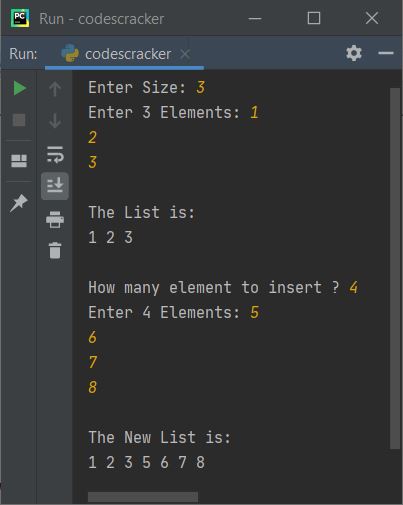
The dry run of above program with same user input as provided in sample run given above, goes like:
- When user enters the size say 3, it gets stored in tot variable. So tot=3
- Now using for loop, the following statement:
arr.append(input())
gets executed 3 times. So three values gets received using input(), one by one and initialized to arr. For example, if user enters 1, 2, 3 as three elements, then arr = ['1', '2', '3'] - Anything received using input() method, treated as a string type value by default
- Now using another for loop, the elements of list named arr gets displayed
- Then using input(), another value gets received from user as total number of elements to insert
- For example if user enters 4 as input, then 4 gets initialized to toti. So toti=4
- And using another for loop, the statement:
arr.append(input())
gets executed four times - In this way, another four elements gets appended to the list named arr. Because, we're using append() method here, therefore element gets added at the end of list
- In this way, multiple elements gets inserted in the list
Insert Element at Specific Index (Position)
As you can see from very first program of this article, the insert() method is used to insert an element at a particular index number specified as its first argument. Therefore using insert() method, this program inserts an element at specified index by user at run-time:
nums = [] print(end="Enter the Size: ") numsSize = int(input()) print(end="Enter " +str(numsSize)+ " Elements: ") for i in range(numsSize): nums.append(input()) print("\nEnter an Element to Insert: ") elem = input() print(end="At what index ? ") pos = int(input()) nums.insert(pos, elem) numsSize = numsSize+1 print("\nThe New List is: ") for i in range(numsSize): print(end=nums[i] + " ") print()
Here is its sample run with user input, 5 as size of list, 1, 3, 4, 5, 6 as five elements, 2 as element to insert, and 1 as index of element to store in the list:
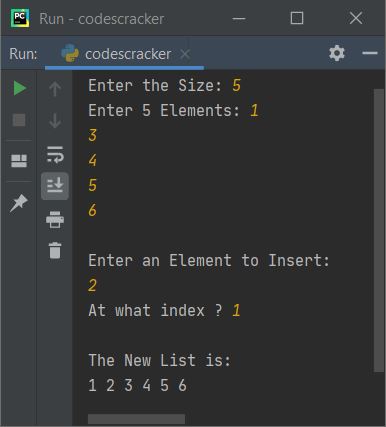
Note - To follow the position's value, then use, nums.insert((pos+1), elem) statement to insert element at given position. Because indexing starts with 0, but generally people referred the 0th index element as first position's element.
Insert Multiple Elements at Given Indexes in List
This is the last program of this article, that is a complete version of inserting multiple elements at given indexes in a list at one execution. This program also handles all type of invalid inputs using try-except:
print("Enter Size: ", end="") try: tot = int(input()) print("Enter " +str(tot)+ " Elements: ", end="") arr = list() for i in range(tot): arr.append(input()) print("\nThe List is:") for i in range(len(arr)): print(arr[i], end=" ") print("\n\nHow many element to insert ? ", end="") try: toti = int(input()) arrdele = list() arrdeli = list() for i in range(toti): print("Enter Element and its Index Number: ", end="") arrdele.append(input()) try: k = int(input()) if k > (len(arr) + len(arrdele)): print("\nInvalid Input!") exit() arrdeli.append(k) except ValueError: print("\nInvalid Input!") exit() for i in range(toti): arr.insert(arrdeli[i], arrdele[i]) print("\nThe New List is:") for i in range(len(arr)): print(arr[i], end=" ") print() except ValueError: print("\nInvalid Input!") except ValueError: print("\nInvalid Input!")
Here is its sample run with user inputs, 3 as size, then 1, 2, 3 as its three elements, and 4 as number of elements to insert in entered list right now. Then 11 as first element and 0 as its index number. Again 22 as second element and 2 as its index number, then 33 as third element and 4 as its index number, and finally 44 as element and 6 as its index number:
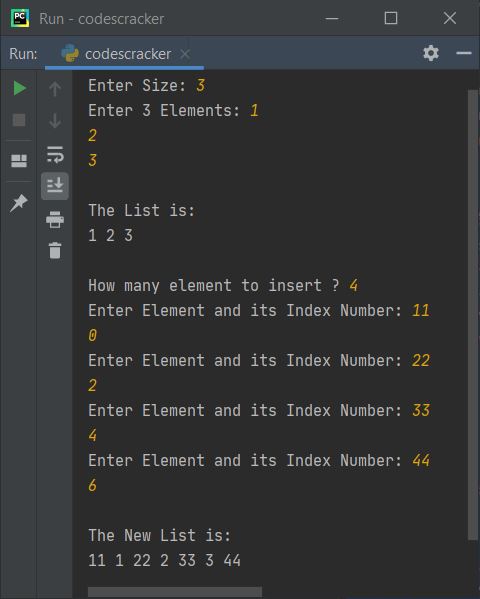
Brief Description of Above Program
The program is created in a way that:
- I've received elements of given size to the list named arr like done previously in above programs
- Then later on, I've used two new lists namely arrdele and arrdeli
- In first list, I've stored all elements that has to be delete. Whereas in second list, I've stored index numbers corresponding to each elements stored in first list
- Then using insert(), I've provided these two lists with its indexes to give index number and element to insert in the list arr
- That is, the statement, arr.insert(arrdeli[i], arrdele[i]), states that the element at ith index of list named arrdeli treated as current index number of arr and element at same index of list named arrdele treated as value to insert in same list. Because I've stored index numbers in list arrdeli, whereas stored elements in list arrdele
The dry run with exactly same user input as provided in previous sample run goes like. This is value evaluation dry run. The output statement does not involve in this dry run:
- tot = 3
- arr = ['1', '2', '3']
- toti = 4
- arrdele[0] = 11
- arrdeli[0] = 0
- arrdele[1] = 22
- arrdeli[1] = 2
- arrdele[2] = 33
- arrdeli[2] = 4
- arrdele[3] = 44
- arrdeli[3] = 6
- Finally, arrdele = [11, 22, 33, 44] and arrdeli = [0, 2, 4, 6]
- Now the main code of insertion, that is:
for i in range(toti):
arr.insert(arrdeli[i], arrdele[i])
begins its execution - So at first execution, i=0
arr.insert(arrdeli[0], arrdele[0]) or arr.insert(0, 11) or arr[0] = '11'. Here 0 and 11 are elements of 0th index of both lists, that is arrdeli and arrdele - So now arr = ['11', '1', '2', '3']
- At second execution, i=1
arr.insert(arrdeli[1], arrdele[1]) or arr.insert(2, 22) or arr[2] = '22' - So now arr = ['11', '1', '22', '2', '3']
- At third execution, i=2
arr.insert(arrdeli[2], arrdele[2]) or arr.insert(4, 33) or arr[4] = '33' - So now arr = ['11', '1', '22', '2', '33', '3']
- Similar thing happened with fourth execution
- In this way, multiple elements gets inserted in a list at given indexes.
« Previous Program Next Program »